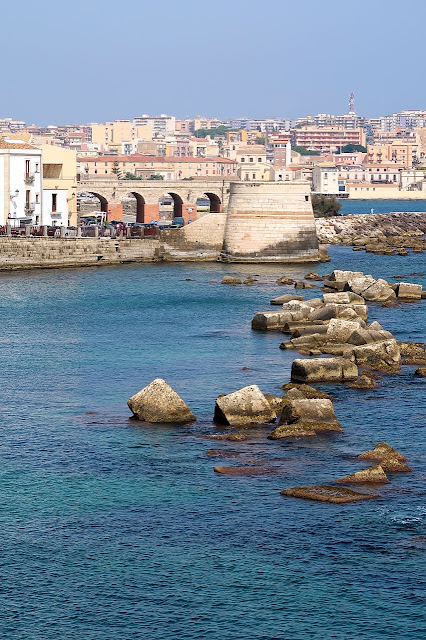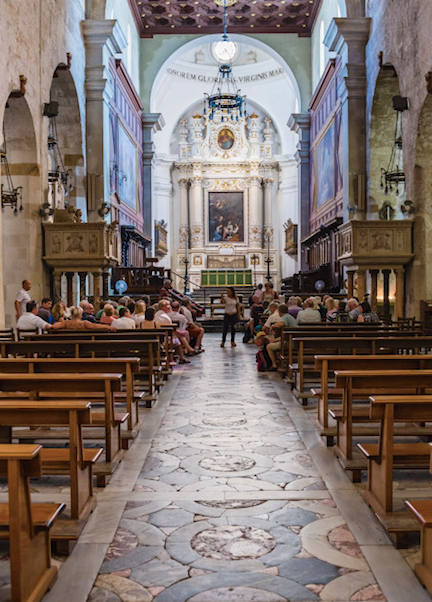Surrounded by the turquoise waters of the Ionian Sea, Ortygia is home to some of Sicily's greatest archaeological treasures. Connected to Siracusa by three bridges, the highlight is certainly the stunning Piazza Duomo. The charm of Ortigia is also its mix of styles: Greek and Baroque but also Roman, Medieval and Norman. The earthquake of 1693 destroyed a large part of the island, which was later rebuilt in the Baroque style, making Ortigia a UNESCO World Heritage Site. Almost every person who visits Ortygia falls in love with the island, it’s sublime architecture, the hospitality of the people, the sea, the view, the breeze and the sights and smells of the historic seafood market. Located beside the market is the site of the Temple of Apollo, dating back to the 6th century BC, it's the oldest Doric temple in Sicily. Although in ruins today, only two of the original columns remain intact along with numerous partial and fragmented columns and one extensive section of wall.
Strolling through the labyrinth of Ortygia's narrow ancient streets, the Cathedral of Siracusa suddenly reveals itself in the magnificent Piazza Duomo. This site dates back to the 5th century BC and the cathedral was actually built around the ancient Temple of Athena, in which the ancient Greek Doric columns of the temple can still be seen inside. Near the southern tip of Ortygia is the Garden of Arethusa with an island of papyrus growing at is centre. One of Ortygia’s most beautiful sites, the garden is actually situated in a sunken artesian pond that flows to the sea, and plays host to a variety of ducks. This area contains a number of outdoor cafes and makes for a great spot to sit and relax while soaking in some Mediterranean sunshine. Perhaps the most beautiful fountain in Sicily, the Fountain of Diana in Piazza Archemede, named after Archimedes, one of history’s greatest mathematicians, astronomers and inventors, the fountain was built to honour the Roman Goddess Diana and depicts the myth of the nymph Arethusa.
Ortygia's most elegant restaurant is Don Camillo specializes in sterling service and innovative Sicilian cuisine. A must for Slow Food gourmands, the refined stone interior provides a tantalizing setting for chef Giovanni Guarneri’s delicious Sicilian cooking. Opened in 1985 by chef-owner Guarneri and by his father "Don" Camillo, this Michelin star restaurant boasts one of the best wine cellars of all Sicilian restaurants, with over a thousand high-level labels. The wine list is, in a word, extraordinary. Arriving for lunch on a hot Sicilian summer day, we were seated in the stone vaulted dining room and offered a glass of champagne, compliments of the chef. The menu with a specialized focus on fish and crustaceans, is simply outstanding. Beginning with a delicious amuse-bouche, we followed with a Leonforte Fava Bean Purée with crispy baccala fritters, and sensational Seafood Crudo with raw shrimp, tiger prawns and langoustine with sea urchin — one of my favourite things. For entrées, we ordered the sublime Spaghetti delle Sirene with ricci di mare and shrimp in butter and perfectly pink sliced Rare Tuna with pepper preserves and Nero d'Avola vinegar reduction, which my husband said was the best tuna he had ever had. An absolutely unforgettable lunch, Ristorante Don Camillo is a culinary gem.
The Ortygia Market full of delicious local fruit andvegetables
The market is open every day except Sundays
Peaches were in season the whole while we were in Sicily and were available everywhere
Fresh local Sicilian pistachios are unlike anything we have ever tasted
The salted capers were too hard to resist so we bought an enormous bag to cook with at the villa and to bring home
The absolute freshest seafood
The Ortygia fish market is famous
Mantis shrimp, or in Italian - Cicale di Mare
Our fishmonger where we bought a gorgeous thick piece of swordfish to cook at the villa
Swordfish, known as pesce spada, for just €12/kg, about a quarter of the price we would pay at home, and exquisitely delicious
The historic Ortygia Market lies beside the Temple of Apollo
Dating back to the 6th century BC, this is the oldest Doric temple in Sicily
The narrow medieval backstreet of Ortygia are charming
Piazza Duomo is considered to be one of the most beautiful Baroque piazzas in Sicily
Open air cafés on Piazza Duomo
The beauty of the The Cathedral of Siracusa dominates Piazza Duomo with its spectacular Baroque facade, was originally a Greek doric temple and for this reason is a UNESCO World Heritage Site
Statue of Saint Paul on the steps of the Duomo
Original Doric columns from the 5th-century BC Temple of Athena on which the duomo was built, are incorporated in the church
The earthquake of 1693 destroyed a large part of the island of Ortygia, which was later rebuilt in the Baroque style such as the interior of the church
The bright creamy stone Palazzo Beneventano del Bosco
The old carriage entrance to Palazzo Senatorio
Palazzo Senatorio, the Senator's Palace built in 1633, is now the City Hall or Palazzo Municipale
A quiet narrow cobbled street with ornate balconies
The seafront promenade or lungomare that runs the entire circumference of Ortygia
Near the southern tip of Ortygia is the Fountain of Arethusa
Wild ducks have made the pond home
The fountain is situated in a sunken artesian pond that flows to the sea
A handsome arancine al ragù from Caffè Aretusa
A labyrinth of atmospheric alleyways
A sleepy Sicilian pussy cat
The Piazza Archimede was created in 1878 with the Fountain of Diana at its centre
Detail of the fountain with water droplets
The piazza was named in honour of Archimedes, one of history’s greatest mathematicians, astronomers and inventors and who was born in Siracusa
We found a wonderful ceramics shop in Ortygia where we fell in love with a gorgeous handmade soup tureen
Handmade Sicilian 3-teir soup tureen from Caltagirone, which we bought in Ortygia and had shipped home
Small van driving carefully through the labyrinth of narrow streets
Having made reservations for lunch at Don Camillo, we strolled through the lovely old Jewish quarter to Via Delle Maestranze in the heart of Ortygia
One of Ortygia's most elegant restaurants, Don Camillo specializes in sterling service and innovative Sicilian cuisine
Don Camillo occupies the remains of a 15th-century convent
Don Camillo menu with a specialized focus on fish and crustaceans, is simply outstanding
The beautiful interior is a perfect setting for chef Giovanni Guarneri’s acclaimed Michelin-starred Sicilian cuisine
Ferrari Maximum Brut Champagne
A dry, elegant and well-balanced bubbly, this complimentary glass of champagne was a gracious way to begin our special lunch at Don Camillo
Polpette di tonno con salsa marinara amuse-bouche
Maitre di Sala Roberto opening our special bottle of 2018 Tenuta delle Terre Nere Bianco Etna Superiore
An absolutely delicious wine, the unique character of the wine is the combination of carricante grapes and the volcanic soils of Etna in northeastern Sicily
Passatina di Fave di Leonforte con fritelle di baccala croccanti:
Leonforte Fava Bean Purée with crispy baccala fritters
I Crostacei Crudi Secondo lo chef con gelato agrodolce di sedano: Raw crustaceans selected by the chef with sweet and sour celery gelato
Chef Guarniere adding the finishing touches on my Crostacei Crudo
Gamberetti crudo
Gamberoni crudo
Raw langoustine with sea urchin
Dal 1999 - Tagliata di Tonno con marmellata di peperoni e riduzione do aceto di Nero d'Avola:
From 1999 - Sliced Rare Tuna with pepper preserves and Nero d'Avola vinegar reduction
Dal 1986 - Spaghetti delle Sirene con gamberi e ricci:
From 1986 - Mermaid's Spaghetti with shrimp and sea urchin - scent of the sea
Caffe Macchiato
Cavatelli e Lampuga alla Siracusana
Serves 4
Recipe courtesy of chef Giovanni Guarnieri
1 lb fresh cavatelli
1 3/4 lb mahi-mahi
1 white onion
12 green olives, pitted and chopped
1 handful of desalted capers
4 ripe and firm tomatoes, peeled, seeded and diced
Fresh basil leaves, finely chopped
1 glass dry white wine
Extra virgin olive oil
Salt and pepper to taste
Fresh parsley
Chilli pepper
Grated Pecorino, optional
Clean, fillet and peel the lampuga. With the central bone and the head prepare a concentrated stock with water, salt, and parsley by boiling for about 1/2 hour then filter the stock. Chop the onion and cook it in a large pan with water and oil. When the water has dried, and the onion begins to brown, then add the chopped olives, capers and the finely chopped basil. Dice the mahi-mahi and add to the mixture. Once they are browned, deglaze with the white wine and add the diced tomatoes. Allow the wine to evaporate, then add the cavatelli and the stock a little at a time, as if it were a risotto. Cook the pasta, adding salt, pepper and chilli pepper to taste, then add the finely chopped parsley. If desired, garnish the dish with a handful of grated pecorino.



























































No comments:
Post a Comment